-
Wreaths from Scratch
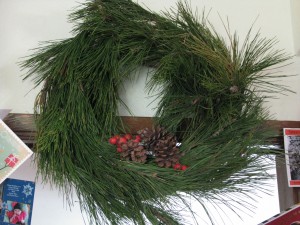
Pine wreath. I haven’t bought a cut tree in ages. I used to buy a live tree, but after so many years of hauling in the heavy 15-gallon container while being face-whipped by the branches, I finally bought a very lovely fake tree about eight years ago or so. It works well, except it doesn’t have the fragrance of a real tree. In the ‘old days’ I could gather cuttings from tree lots, but the sellers caught on and now sell them or use them for wreaths themselves. I’ve been buying a wreath from Trader Joe’s which smells nice for awhile but is pretty expensive for just some branches.
This year my daughter and I used bits of plants that we trimmed as we pruned our fruit trees. Some pine branches had been left unshredded in the huge mulch piles I nabbed from my neighbor’s tree trimmer after they topped (shudder!) all his trees.
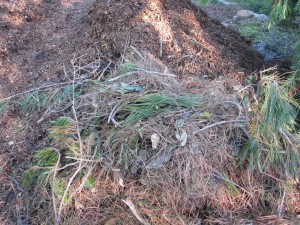
Pine branches that missed being shredded from the neighbor’s tree butchering (I grabbed the mulch for my yard!) A large eager rose had hung some large lovely hips low over the pedestrian gate and needed trimming back.

Fourth of July rose hanging low over the gate. A rosemary bush was encroching on a fruit tree and was cut firmly back. We cut some willow and sage as well. So one night last week my daughter and I had a ‘craft night’ and on spread newspaper with the help of wire and old wreath frames made three wreaths, a centerpiece and a huge mess on the floor.
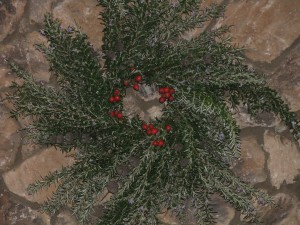
A fragrant rosemary wreath studded with rose hips and some sage seed pods. 
Pine needles and cones with rose hips. Love to hang my Christmas cards! 
Curly willow cuttings woven into a wreath and studded with rose hips. My daughter is very creative. We had a lot of fun, and the wreaths smell of herbs.
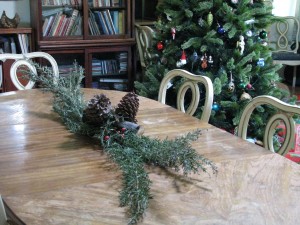
Leftover rosemary became a centerpiece with the help of a small piece of firewood and some pinecones. What can you do with what you have growing?
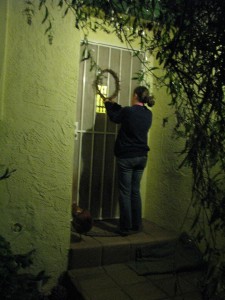
My daughter hanging the willow wreath while Viola the hen gives advice (its past her bedtime. The hen’s, not my daughter’s.) -
Building With Bamboo
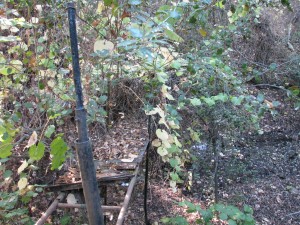
Rotten plywood and downed branches cover the old bridge. Part of a sustainable garden is the growing of building materials. If you can’t have a wood lot, then temperature permitting you can grow clumping bamboo. You can grow ‘running’ bamboo if you’d like, but it would be wise to keep it contained in pots or you’ll end up with a major headache such as I had last January trying to remove it. The bamboo in my yard has happily grown into giant plants with wonderfully tall, strong shoots that are ready to harvest. I have several projects in mind, but the most fun and appealing has been the refurbishing of an old bridge.
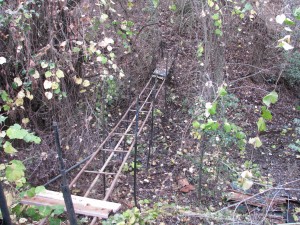
All the old stuff had to be stripped off the framework. The bridge was sprawling across the barranca when we moved here 13 years ago. Although the pipes screwed together were actually solid enough, the plywood, tar paper and carpeting that made up the walkway was well on its way to rot.

The metal frame looked bad but actually was stable. The other side of the barranca is home to poison oak, and getting to the bridge was difficult as erosion diminished the hillside. Now through permaculture, the erosion has been eliminated and thanks to Roger Boddaert and his crew there is a wonderful walkway down to the bridge. However, the bridge was unusable and had broken branches hanging over it. The barranca itself is very beautiful and a wonderful bird-watching location, so revitalizing the bridge with natural building materials would turn the eyesore into a beautiful addition to the gardens.

Jacob and Steve harvesting bamboo. Jacob Hatch and his father-in-law Steve have had the task of harvesting, splitting and working with the bamboo.That is because, as I’ve admitted freely in past posts that my building abilities rate right up there with my ability to cut hair, with about the same disasterous results. I can see what I want in my mind, but my hands aren’t paying attention.
First Jacob and Steve had to clear the bridge of the tar paper and rotted plywood and test the metal pieces for strength.
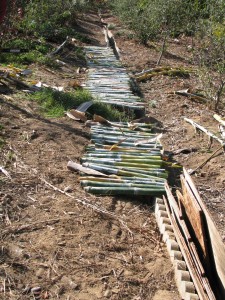
Bamboo cut to lengths. Working from a library book, they harvested the heavy water-laden shoots. After cutting the pieces to the correct width for the bridge, they used a sharpened old knife and a rubber mallet to split the stalks.
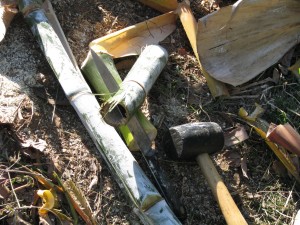
A rubber mallet and sharpened knife were all that was needed to split the bamboo. UnfortunatelyInside the sheaths there was a black fuzz that caused both of them to itch. Steve and a third helper Jake screwed the horizontal pieces onto the long supports.

Steve and Jake screw bamboo onto the frame while Sophie looks on. They built sections, then carried them down and installed them on the existing bridge poles, with the long pieces of bamboo fitting outside of and hiding the metal. Bamboo was then wired on to the uprights, and a railing was installed.

The walkway laid out. Finally the ends were tied with sisal rope. This added strength as well as beauty to the finished work.
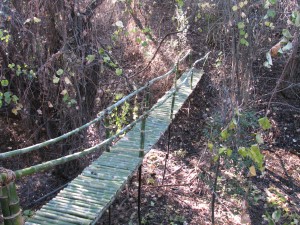
Bamboo railings in place with sisal ties and wire. The bamboo is still green; as it ages it will cure. Beads of oil will form on the top and the oil will be rubbed into the bamboo to strengthen it even more as it hardens and dries. Right now the bamboo is a little slippery to walk on, especially when damp. The bridge was built with a slight downward slope to it as well.

Strong enough for two big men: Jacob and Steve on the finished bridge! Ta-da! A really terrific and usable bridge! It certainly won’t pass OSHA safety standards, but its fine for a private home with no little kids around. The barranca looks like some exotic location, built with materials grown on site. Next projects include a small bridge, a short pier for the pond, and a ‘moon gate’ trellis for the passionvine that is out of control. Good thing I have a lot of bamboo.
-
The Withy Hide at Ten Months
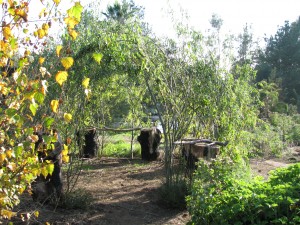
The entrance. Last February I wanted a photography hide and decided to make one out of willow (withy). I cut stalks of curly willow which I already had around the property, stuck them in the ground near the subterranean irrigation lines in a ten-foot diameter, and hoped for the best.

I see a bird! Curly willow tolerates less water, direct sunlight and heat better than the native willows, as well as being delightfully kinky.
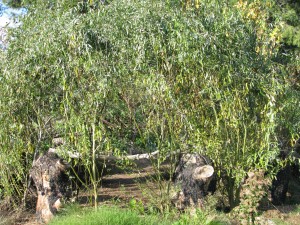
Closer view of the front. The willow grew immediately, gradually sending out tall shoots and lots of leaves. Most withy structures are created with straight willow sticks that are crossed and either tied or woven into a pattern.

A duck’s eye view. Since I began with irregular pieces and the nature of the willow is very curly, I just let it do its thing and figured that abundance would make a good hiding spot. It did.
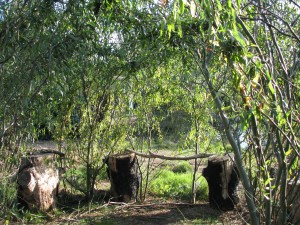
Inside.. A few weeks ago I took some of the tallest stalks and tied them together overhead to create something of a dome shape. I’m not sure how the willow will adapt to the changes, but they ought to begin to grow in that curved shape. I didn’t tie all of them because I wanted a wild look, just semi-tamed.
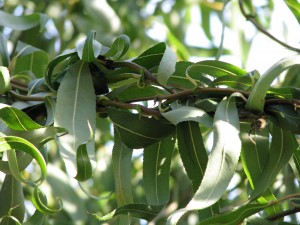
Tying the willow tops together. The willows are already beginning to lose their leaves, creating a wonderful mulch underneath. While the willows are bare there won’t be as good of a hiding spot, but as more stalks grow next year it should fill up beautifully.

Side view. 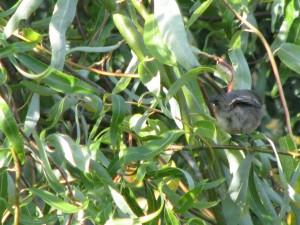
A bird butt. Who is hiding from whom? - Animals, Books, Breads, Chickens, Compost, Gardening adventures, Giving, Health, Humor, Permaculture and Edible Forest Gardening Adventures, Pets, Recipes, Reptiles and Amphibians, Soil, Vegetables
The Life of Di, or Fall At My House
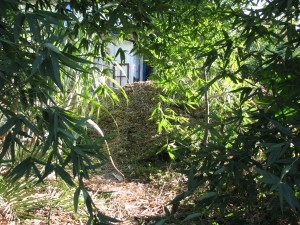
“And here’s another fine mess you’ve gotten me into!” I like to be involved with many projects at once. I picture my life as an opal, my birthstone, full of swirled colors and hues. I have several books going at once, projects chipped away at around the house, volunteer responsibilities strewn across my week, and far too many animals and acres to care for. When I’m exhausted I can spend a day on the couch reading with no trouble at all being the picture of laziness. Prior to Thanksgiving I underwent a skin cancer preventative treatment on my face and hands, which required applying a topical cream twice a day that brings suspicious cells to the surface and burns them off. By the end of the second week I was quite a mess, and then took another week to heal enough to be seen in public without alerting the zombie hunters. The treatment, needless to say, kept me from being in sunlight, therefore housebound. Always loving a clean, organized house but never actually completely cleaning or organizing, I figured I’d get some work done. I tried sorting about 15 boxes of photo albums left by my mother and grandmother… and got through one box before I had to stop. I wanted to bake bread, and I wanted to find something to do with the small amount of hops we harvested, so I experimented with a recipe that had a starter, sponge and rising that altogether took five days. The Turnipseed Sisters’ White Bread from the classic Bernard Clayton’s New Complete Book of Breads .

Turnipseed Sisters’ White Loaf starter made with hops. The starter really smelled like beer. Not in a pleasant way, either. However the bread was good, and baking was fun.

Good sandwich and toast bread. Just the extra carbs I needed for sitting on my butt for two weeks, right? Then I wanted to thin, clean and alphabetize the fiction section in my living room.

Books piled alphabetically… a little later there was a small avalanche. Yes, I have enough books in my house that they are in sections. Former school librarian and bookstore worker here. I haven’t done the non-fiction section as yet, which extends to most of the other rooms in the house. Maybe next year? I did a little writing, a lot of reading, surrounded by my elderly dog Sophie

Sophie enjoying good sleeps. who keeps returning from the brink of death to sleep about 23 hours a day, and one of my hens, Viola, who suddenly went lame in one leg.

Viola on a healing vacation. All advice was to cull her, but I thought that she pulled a muscle and hadn’t broken her leg, and being vegetarian I don’t eat my pets. Viola has been recuperating in a cage in the dining room, gaining strength in that leg, laying regular eggs, having full rein of the front yard, and crooning wonderfully. As I count wild birds for Cornell University’s Project Feederwatch, I keep an eye on the hen. The cats ignore her, thank goodness. I’ve quite enjoyed having a chicken in the house. Yep, I’m starting to be one of those kinds of aging ladies.
In between I’d spend time crawling under bushes to push and shove my 100-pound African spur thigh tortoise out of his hiding spot and into the heatlamp-warmed Rubbermaid house he shuns so that he wouldn’t catch cold in the chill damp nights. I always come out victorious, with him angry and begrudgingly warm, and with me wet, muddy, hair full of sticks and hands full of scratches. Does anyone have a life like this?
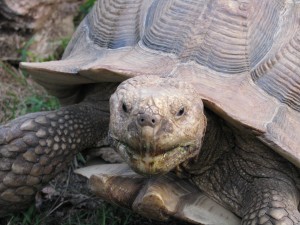
“I’m performing advanced trigonometry in my head, don’t bother me, Woman!” Finally my skin healed enough so that I was able to venture outdoors.
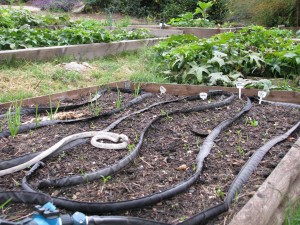
Garlic and seed sprouts guarded from birds by a rubber snake. I planted seeds of winter crops: collards, kale, garlic, onions, carrots, Brussels sprouts and broccoli rabe, and prepared raised beds for more.
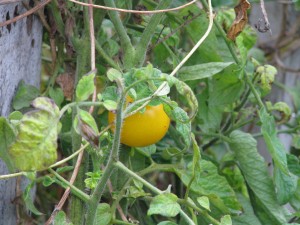
Yellow perfection tomatoes still ripening, as are the green zebra. I ordered organic pea, lupine and sweet pea seeds from Baker Creek Heirloom Seeds , all nitrogen-fixers to plant around the plant guilds.

Pepperoncini still producing. On Thanksgiving I hiked 1200 feet up Monserate Mountain in a record slow time; all that sitting and all that bread causing me to often stop and watch the slow holiday traffic on Hwy. 15, and be very glad that I was on a hike instead.
The neighbors had their annual tree butchering, paying exorbitant sums to have the same so-called landscapers come in and top their trees (shudder!) and thin others… for what reason I have no idea. Because being retired Orange County professionals they believe that trees need to be hacked back, contorted, and ruined? Possibly.
Please, please, please, friends don’t let friends top trees! Find an arborist who trims trees with an eye to their health and long-term growth and immediate beauty. A well-pruned tree is lovely, even just after pruning. A topped tree is brutal and ugly.

A topped coral tree. Ugh! Anyway, the upside is that I claimed all the chips, giving new life to the ravaged trees as mulch for my pathways. Two truckloads were delivered. I think I have enough for the whole property.
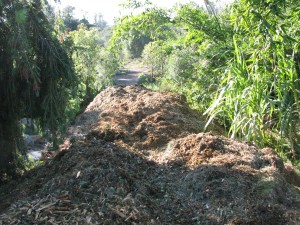
“The bear went over the mountain to see what he could see. He saw another mountain…” How to spread it? Yep, one wheelbarrow full at a time.
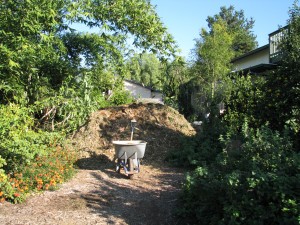
One wheelbarrow at a time. I can now condition myself for more hiking and weight lifting without leaving the property. The heaps have a lot of pine in them (they thinned the pine trees!???) so there is a pleasant Christmassy smell emanating from the heaps.
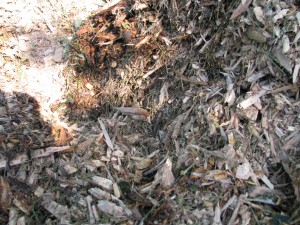
Hot steamy mulch. They are also very high nitrogen and were hot in the center on the second day and this morning were steaming right after our brief rain shower. Mulch piles can catch fire; when I worked for San Diego County Parks we rangers would joke about who had been called out by the fire department when their newly delivered mulch pile had caught fire in the night.
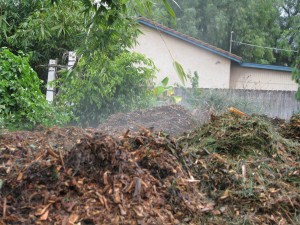
Steam from the mulch mountains. I stood on it just now and steam went up my pant legs and warmed me up! I also received a gift of seven 15-gallon nursery containers of llama poo!

The wealth of llama poo. Hot diggity! Early Christmas: My diamonds are round and brown, thank-you. I layered them in the compost heap and am ready for more.
I also wholeheartedly participated in Small Business Saturday, finding happy locals and crossing paths with friends and aquaintences at several stores. I received my first Merry Christmas from a man at Myrtle Creek Nursery’s parking lot as he waited for his son’s family to pick out a Christmas tree. I do love this town.
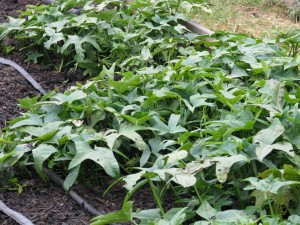
Sweet potatoes ready to harvest for Christmas dinner. That catches me up. Lots of projects, lots of volunteering, lots of cleaning up to do before my daughter comes home for the holidays and despairs at my bachelorette living. Lots of mulch to move. Lots of really great friends. Lots of sunscreen to wear. Lots to be thankful for.
- Animals, Gardening adventures, Natives, Other Insects, Permaculture and Edible Forest Gardening Adventures
At Least 78 Reasons Why You Shouldn’t ‘Clean Up’ Your Garden
The idea of cleaning up all the dead plants out of the garden in the Fall has been so drilled into us that it is almost second nature. There are a certain amount of things to do in a garden in the Fall, but second-guessing nature’s usage of plants shouldn’t be one of them. Leaving seedheads standing provides birds with something to eat when scavenging becomes difficult – and for a perch. Not being so radical about cutting back or pulling out plants that don’t look as good as new may provide you with pleasant surprises. For instance, last month I saw that milkweed plants had been eaten down by Monarch butterfly larvae until there wasn’t a leaf on them. The caterpillers were gone and there were a couple of the beautiful Monarch butterflies landing on the lantana and butterfly bush for a drink. I left the plants, and sure enough, they produced more leaves. Then this week, the week before Thanksgiving – so late in the season – I happened to look at the milkweed and saw that it was bare again.

A bare looking milkweed plant. Then I took a closer look.

And then I stared.

One one milkweed plant there were well over fifty Monarch caterpillars, and on a smaller plant over twenty.
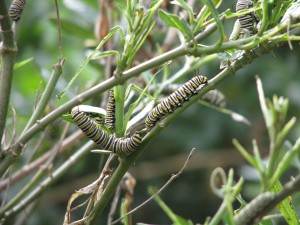
They were hurrying to eat what they could.
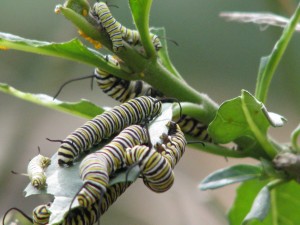
Many wouldn’t make it through metamorphosis this late in the season, but many will.
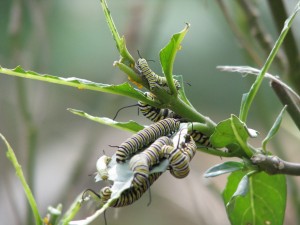
However I’ve since seen these beautiful creatures all over the yard looking for suitable places to fasten on to, to form their green and gold cases and try their luck at metamorphosing. Perhaps there will be Monarchs in the yard at Christmastime.

I’m glad that I’m a sloppy gardener.
-
Preserving Squash and a Terrific Pumpkin Chai Recipe!

Beautiful patterns on the banana squash shell. Four sugar baby pumpkins that I’d kept for myself, and three pink banana squash, were all in need of preservation. They were not keeping well due to the warmth of our hot San Diego county Fall. During a rainy break in the weather I did something about it. You can preserve cooked pumpkin and winter squash best by freezing it. If you have a pressure canner you may can pureed pumpkin or pumpkin pieces in liquid, but since I only use the water bath method that wasn’t an option.

Even sugar baby pumpkins can be difficult to cut when raw. There’s a better way! Roasting a squash isn’t difficult at all. In fact, you only have to wash it, put it on a tray in a 350F oven for about an hour (longer if its a really large pumpkin), and then slice when cooled.

Roasting a whole pumpkin makes the scooping so easy! Its easy to scrape out the seeds and then spoon out the cooked flesh out of the hardened shell. This is what I did for the sugar baby pumpkins. There was too much banana squash to fit whole into the oven, however, so I cut them into chunks, scooped out the seeds, covered them with aluminum foil (it helps steam them) and baked 350F for forty-five minutes.
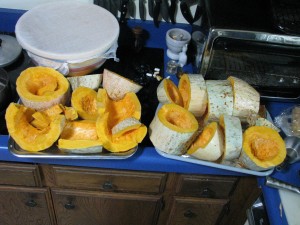
Three banana squash is a lot of squash I have more details here. I also roasted the pumpkin seeds.
Then I had a lot of squash to puree! These squash and pumpkins were dry, so I added a little water to the VitaMix and tossed in the chunks.
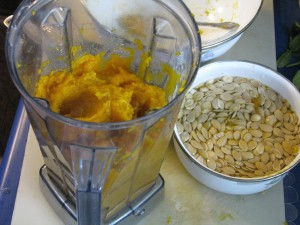
Pumpkin and seeds. I pureed batches until smooth, then spooned cups full into freezer bags. My pumpkin scone recipe calls for only half a cup, so I froze one-cup batches, as well as two-cup batches for pie. The secret to ‘vacuum-packing’ freezer bags is to close the top of the bag around a straw and then suck all the air out. It really works well, and is kind of fun, too.

Get a straw, suck out the air and presto: vacuum packed! However, the best thing that happened out of all this squashing was that I had a little less than a cup of pureed roasted squash left in the VitaMix, too little to freeze and really irritating to scoop out. It was a cold day and past lunchtime. I had an idea and spooned in what was left of some Chai tea mix, poured in vanilla soy milk, blended it until it warmed up and sat down to drink. Heaven! I’m not one for pumpkin flavored things, but this was the real deal.
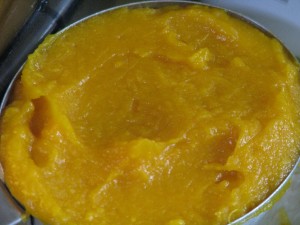
Pumpkin puree. It was so good that the next day I took a cup of the pureed squash that I refrigerated, poured in 1 1/2 cups of vanilla soy milk, a touch of orange syrup left over from candying orange peel, added cinnamon and blended until it was hot. It was thick, satisfying, a little sweet, spicy and full of beta carotene, fiber, protein and other good things. I’m sure you can do the same thing with canned pumpkin and other liquids, such as milk, rice milk, almond milk or coconut milk. If fact, I insist that you try it.

Hot Yum! Pumpkin ChaiAuthor: Diane C. KennedyRecipe type: BeverageCuisine: AmericanPrep time:Cook time:Total time:Serves: 2Cold or hot, spiced pureed pumpkin or squash mixed with the milk of your choice is extreme comfort food that is actually terrific for you!Ingredients- 1 cup cooked pumpkin or squash puree, fresh or canned.
- 1½ - 2 cups vanilla soy milk, or milk of your choice. (Less for a thick drink).
- ½ - ¾ teaspoon cinnamon, pumpkin pie spice or up to 1 scoop Chai tea mix.
- Sweetener (optional); a natural syrup would do or honey.
- ½ teaspoon vanilla (optional)
Instructions- For cold pumpkin chai mix all ingredients briefly in a blender or VitaMix.
- Taste to adjust seasonings, thickness and sweetener, and serve.
- For hot pumpkin chai, heat milk and add to the rest of the ingredients in a blender and process. If you have a VitaMix, you can add all cold ingredients and then process until it is hot.
I’m going to make some more for me right now. -
Yes There Is A Bleach Alternative That Works!
Bleach does wonders for whites, kills germs and purifies water. It is also a toxic chemical, it kills the microbes in your septic tank, it corrodes what it touches and can do your lungs, skin and eyes major harm, especially when combined with other chemicals. Many over-the-counter natural cleansers seem weak and probably don’t do a good job disinfecting, besides being very costly. Here is a recipe for success: a safer bleach alternative that really works. Vinegar is of course a fantastic cleaner, but if the pervasive smell of Easter eggs is too much for you, then how about the smell of citrus? I have plenty of lime trees so I have an ongoing supply of lime juice, but an inexpensive bottle of lemon juice works as well. I’m going to direct you to a blog link on Grit magazine’s ezine, because I certainly can’t do better than Lucy Razor’s very through and well-researched article. So here is the recipe for natural bleach alternative. Now go make up a batch!
- Compost, Gardening adventures, Natives, Permaculture and Edible Forest Gardening Adventures, Soil, Vegetables
Leave the Leaves

The world can be saved with leaves. Yep. No kidding. We are in a season named after leaves: Fall. When deciduous trees drop their leaves they are shutting down their systems for the winter. In warm climates native plants don’t do this, rather they shed leaves over a period of time, never turning off their ability to create food through photosynthesis. Evergreens also do this, providing shelter and food for animals no matter the weather. In cooler climates many trees go into semi-dormancy, kind of a half sleep.

Liquidamber trees provide gorgeous Fall color and lots of great leaves. They reduce the number of leaves on their branches so that their productivity reduces but doesn’t completely stop. In cold climates many trees become living works of art as their leaves turn colors before falling. Much has been made of the beautiful sight of bare branches in a winter garden. A traditional Fall activity is the raking and disposing of fallen leaves. Happy kids jumping into leaf piles. However, we need to stop thinking that bare is beautiful; at least, as far as the soil is concerned.

Plant trees that will provide you with lots of leaves. The disposal of fallen leaves should be made an environmental crime. Trees drop their leaves to protect and feed their roots, and all the microbes that aid and abet them. Those decaying leaves also protect and feed bulbs, shrubs and other overwintering plants. Ever notice how snow melts around leaves and fallen branches first? That is because they also produce warmth as they decompose, warming the soil to keep the microbes alive.

The whiteness is fungus breaking down the twig. The leaves are breaking down into rich, fragrant soil. To remove fallen leaves is to take away the tree’s food, nutrition, its disease and pest control by pest control san diego and ultimately its health. It would be as if you had stored up a cabin for the winter with healthy food and supplies, and someone came and took most of your supplies except junk food, took your blankets, your firewood and your vitamins and medicines. You’d probably survive until Spring, but you wouldn’t be very healthy, and you’d stay in a hospital and be treated with drugs to combat the illnesses and injuries you accumulated. Your health would be greatly weakened.

A young sycamore just starting its leaf accumulation. This is what leaf removal does for trees. People rake up the leaves in the Fall, then in the Spring buy fertilizer (usually chemical thanks to persuasive advertising), insecticides, foliar sprays and other junk that they don’t need, take time and effort and mess to apply, are often a human health hazard if inhaled or touched, and are expensive. None of this is necessary, if people would only do less work and stop interfering. If they would leave the leaves, plant companion plants around the trees along with natives, everyone would be healthier.

Rich avocado mulch. People rake leaves and dispose of them because the leaves come from specimen trees usually dotted around lawn areas. Lawns are unnatural. Fun, pretty, functional, but unnatural. Grass doesn’t like leaves on top because the leaves block the light. Exactly. A layer of leaves around the base of the tree will prevent invasive weeds and grasses from stealing rich topsoil.

Citrus leaves and fruit. Even in grove situations, or under fruit trees, people are determined to clear every leaf off the surface of the dirt. Notice I say dirt, not soil. The trees know what they are doing; they know what they need and dropped leaves and fruit are there on the ground for a purpose. They feed the soil and thus the tree.

Leaving vegetable vines to decompose enriches your garden beds. What can be the compromise? Allow the space under your specimen trees to be cleared of grass up to and a little beyond the drip line of the tree; further would be better. When leaves fall, rake them all under the tree, being careful not to pile them up around the trunk. Plant all the shade-loving plants and bulbs that you’d like to within that space, but include members of a plant guild: a nitrogen-fixer, a groundcover, a deep tap root that mines the soil, a mulch plant, a pollinator, etc.

A leaf haven. This old oak has a large root base. I collect the leaves off the stairs only, and they are used to charge the soil under new oaks. Children like to play under the trees? Afraid of creatures lurking in the leaves? Then leave a space for human interaction. Make a barrier with stones or decorative edging that circles a little more than the drip line of the tree, but then cuts back to the trunk to leave a large wedge shape. Leave the leaves and fruit within the barrier, and keep the wedge clear for sitting and playing.

California peppers are one of many trees that drop leaves which emit a chemical that discourages competition from other plants. Still too many leaves? In their natural settings deciduous trees produce leaves enough to cover their roots and also the space between trees, which protects the fungal passageways that connect the tree roots. With a specimen tree that isn’t happening. What to do? Compost! Build an inexpensive bin with wire or pallets and cram the leaves in. Each leaf is a vitamin pill for your garden. Go in with your leaf-burdoned neighbors on the rental of a shredder and shred everyone’s extra leaves. Mulch all your garden beds and your lawn with shredded leaves. They will break down faster, heat up more quickly in a compost heap and take up less space. Your soil will turn into rich, fragrant loam.

Pine needles are high in acid; great to even out alkaline soils. Stilltoo many leaves? Post ‘free clean leaves’ on Craigslist or on your community bulletin board. Gardeners crave leaves, and may even come out to rake them up for themselves.

I only wish the leaves were this deep! The broom is just worn to a nub. Please, please don’t send your excess leaves to the landfill. The soil desperately needs those leaves and with them you won’t have to resort to chemical fertilizers, chemical sprays, high expenses and heavy labor in the Spring. You can instead spend the time watching your garden thrive.
-
Change in Status
I want to petition Facebook to add another relationship choice for my status. Single is such a lonely word. If you’re young, then to be ‘single’ means ‘available’. When you’re middle-aged, single means ‘bad relationship history’, or ‘too much baggage’, or ‘was always chosen last for sports in school and nothing has changed.’ To have a status of single is camouflage for the ugly ‘divorced’ term or the sad ‘widowed’ term. None of these evoke attention or enthusiasm on the part of the beholder. Over a certain age the question isn’t, “Are you single?”, but “WHY are you single?” In other words, “What is wrong with you?” Then anyone checking you out starts searching your Facebook albums for photos of a huge number of children who don’t match each other, or a long suspicious gap in your employment dates. To be listed as single when middle-aged is negative; its depressing. Its lonely.
That is why I want to change my relationship status from ‘single’ to ‘unsupervised’. How much more freeing and exciting is it to be unsupervised than just single? It conjures up wild abandon, mysterious trips, breaking rules, being silly and being old enough to get away with it all. Unsupervised: the no-no of the classroom, the parental horror of the teen years, the anathema of the workplace. How fun is that? Single + middle aged = rocking chairs and increased doctor visits. Unsupervised + middle aged = spontaneity and surprises.
So I will consider myself unsupervised and see if the change in term also liberates my behavior even a little.
But then, I have cats, so maybe I can’t consider myself unsupervised. Especially at dinnertime.
-
Summer Tasks That May Be Too Late To Do

Dutchman’s Pipe eating my lawn chairs. 
The lawn chairs are on the second floor balcony. 
Notice it taking a quick look through the sliding glass door leading into my bedroom, and noticing all that unused space. 
I don’t mention the word c.l.i.p.p.e.r.s. outloud up here. Umm… help!
